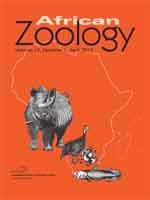Two coexisting species of African molossids, the little free-tailed bat, Chaerephon pumilus, and the Angolan free-tailed bat, Mops condylurus, were studied in the lowveld of Swaziland. Nine C. pumilus and five M. condylurus, all non-lactating females, were radio-tracked in order to investigate their habitat utilization. The results confirmed that both of these species selected to forage over sugarcane fields instead of over the other habitats available in the area: savanna, riparian forest and urban areas. Foraging ranges were relatively large with C. pumilus travelling on average a maximum of 4.2 km from the roost and M. condylurus covering 4.8 km. The mean activity areas ranged from 976 ha (minimum convex polygon) to 1319 ha (95% kernel) for C. pumilus and from 1190 ha (MCP) to 1437 ha (95% kernel) for M. condylurus. Interspecific differences in the mean activity area or maximum distance travelled were not found. The results of this study suggest that these species have a potential role as pest-controlling agents over sugarcane fields.
How to translate text using browser tools
1 April 2012
Molossid Bats in an African Agro-Ecosystem Select Sugarcane Fields as Foraging Habitat
Christina Lehmkuhl Noer,
Torben Dabelsteen,
Kristine Bohmann,
Ara Monadjem
ACCESS THE FULL ARTICLE

African Zoology
Vol. 47 • No. 1
April 2012
Vol. 47 • No. 1
April 2012
Chiroptera
foraging habitat
habitat selection
Molossidae
telemetry




